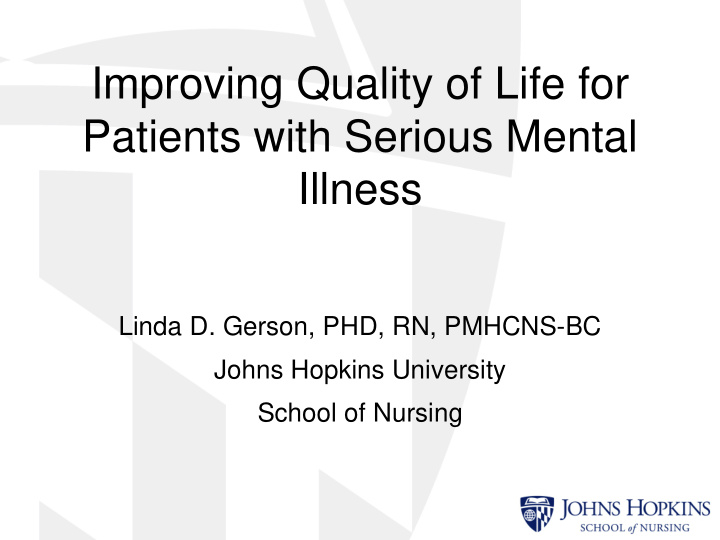



Improving Quality of Life for Patients with Serious Mental Illness Linda D. Gerson, PHD, RN, PMHCNS-BC Johns Hopkins University School of Nursing
Why this focus? • US Surgeon General’s Report (1998) – Impact of untreated mental illness • IOM Report: Unequal Treatment (2002) – Racial and ethnic disparities • President’s New Freedom Commission Report (2003) – Problems in delivery of effective health care to mentally ill persons in US – Call to transform healthcare system to become more consumer and family-oriented
Prevalence of Serious Mental Illness Among US Adults Data Courtesy of SAMHSA
Purpose of this pilot study • Identify individual and family perceptions of their mental health care experience • Target interventions that are responsive to individual and family needs
Procedure • Informed consent and contact information • Home visits • Patient and family interviews
Instruments • Brief Psychiatric Rating Scale (Overall & Gorham, 1962 • Personal Resources Questionnaire (PRQ) Part II (Weinert, 1988) • Ways of Coping Checklist (Folkman, Lazarus, Dunkel- Schetter, DeLOngis, & Gruen, 1986) • Camberwell Assessment of Need Short Appraisal Schedule (MacPherson, Varah, Summerfield, Foy, & Slade, 1999) • Client Satisfaction Questionnaire ( CSQ) (Larsen, et al. 1979) • Four open-ended interview questions
Data Analysis • Descriptive statistics • Measures of central tendency • Manifest and latent content analysis (Rose, 2012 developed codes)
Characteristics of study participants • 10 participants • Ages 23-81 years • All were African American • 6 men, 4 women • Diagnosis of schizophrenia, major depression, or bipolar disorder
Results • BPRS —not enough difference in scores between Time 1 and Time 2 to support improvement • PRQ —increased social support immediately after discharge, but less as time went on • Ways of Coping —little change in coping over time • Camberwell —unchanged from Time 1 to Time 2. Unmet needs: • Daytime activity • Intimate relationships • Help with reading and writing
Interview Findings • Concern about on-going symptoms and difficulty managing them • Adjustment to community impacted by: • Follow up care • Family support • Patient perception of health status • Family – Resignation – Frustration – discouragement
Recommendations • Provide support after hospital discharge for both patients and their family members • Add structure and activities to patient’s daily routine • Enhance community-based treatment programs by focusing on communication of patient and family goals • Create a strong therapeutic alliance with the patient and their family
References • Folkman, S., Lazarus, R., Dunkel-Schetter, C., DeLongis, A., & Gruen, R. (1986). Dynamics of a stressful encounter: Cognitive appraisal, coping, and encounter outcomes. Journal of Personality and Social Psychology , 50, 992-1003. • Larsen, D., Attkisson, C., Hargreaves, W., & Nguyen, T. (1979). Assessment of client/patient satisfaction: Development of a general scale. Evaluation and Program Planning , 2, 197-207 • MacPherson, R., Varah, M., Summerfeld, L., Foy C., & Slade, M. (2003). Staff and patient assessments of need in an epidemiologically representative sample of patients with psychosis: Staff and patient assessment of need. Social Psychiatry & Psychiatric Epidemiology , 38, 662-667. • Overall, J., & Gorham, D. (1962). The brief psychiatric rating scale. Psychological Reports , 10, 799-812. • Weinert, C. (1988). Measuring social support: revision and further development of the personal resource questionnaire. In C. Waltz & O. Strickland (Eds.) , Measurement of Nursing Outcomes (pp. 309-327). New York: Springer.
QUESTIONS AND DISCUSSION
Contact Information • Linda D. Gerson, PhD, RN, PMHCNS-BC • Johns Hopkins University School of Nursing • 525 N. Wolfe Street • Room 416 • Baltimore, Maryland 21205 USA • Telephone: 1-410-614-5747 • Email: lgerson1@jhu.edu
Recommend
More recommend